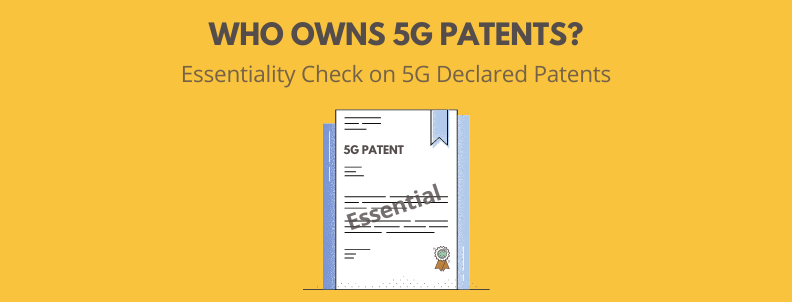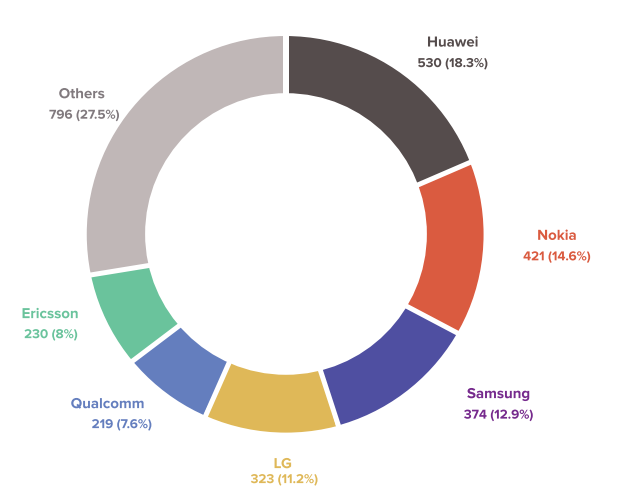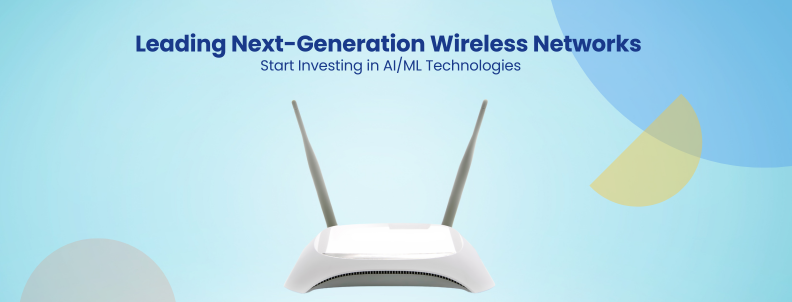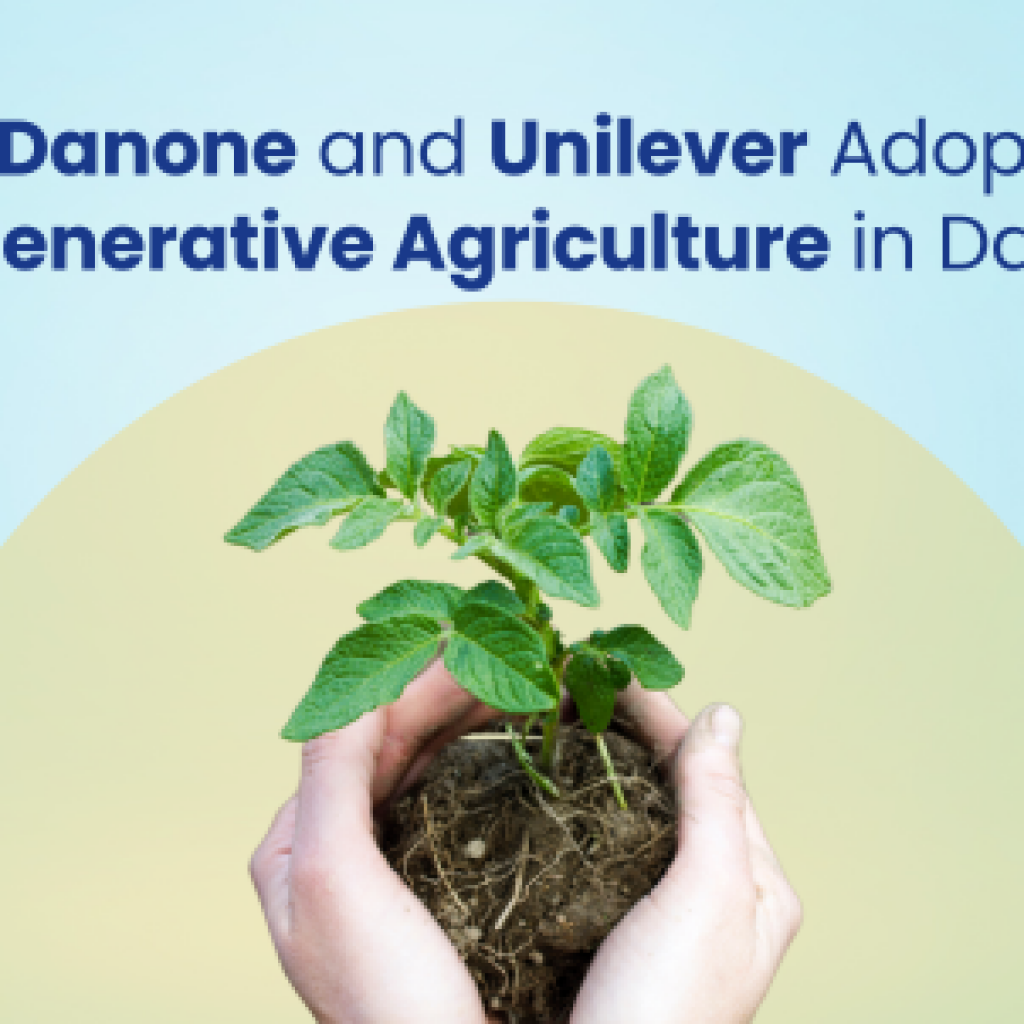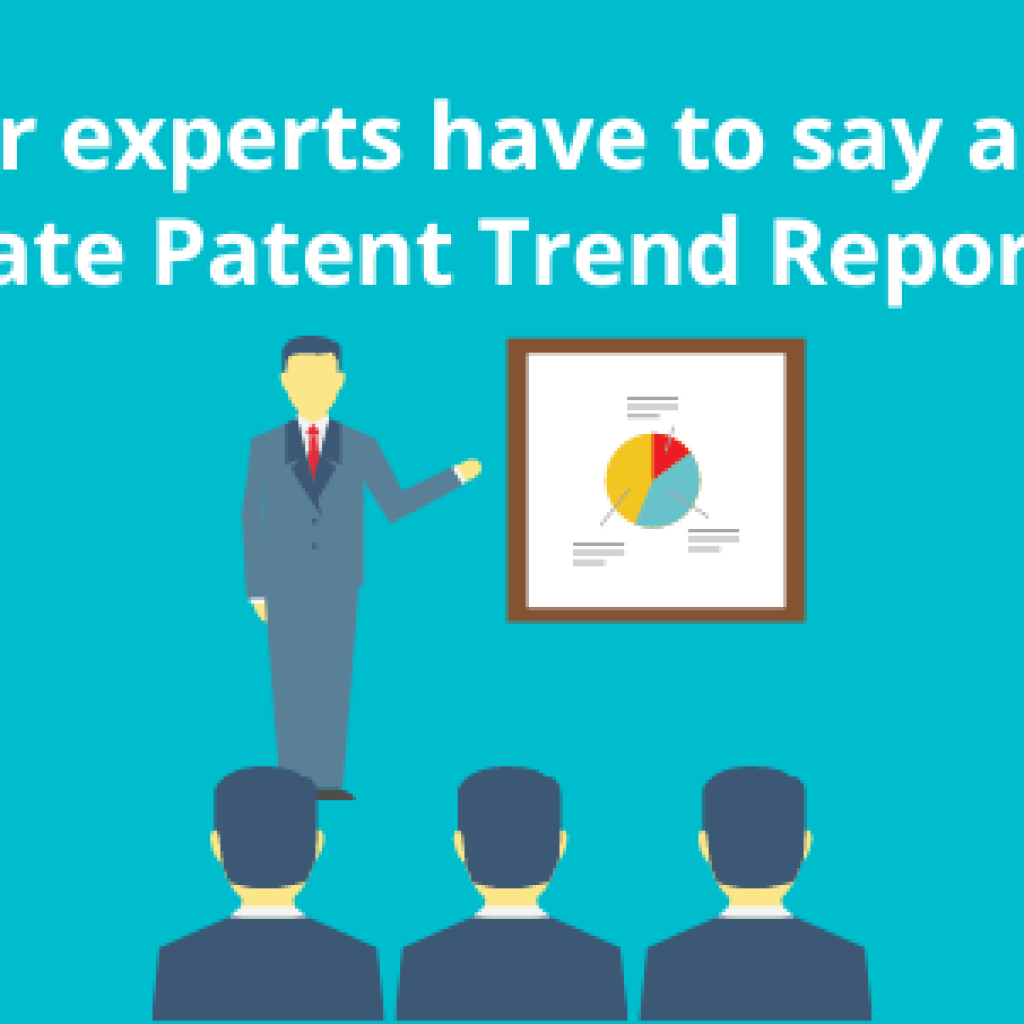This report is an update to the report titled “Exploration of 5G Standards and Preliminary Findings on Essentiality” published May 26, 2020. This report covers more than 700 technical specifications and technical reports related to 5G technology covered in the 3GPP Portal. The scope of the prior report covered 12,002 patent families, having 63,985 individual patent documents, declared as of March 19, 2019. This scope has increased to 18,887 patent families, having 87,771 individual patent documents, declared as of November 26, 2019. In the prior report, 6,402 of the 12,002 patent families had a granted alive patent. This update sees 4,361 additional patent families now with a granted alive patent. In case if want to view the previous version of this report. Click here.
As we create and consume ever greater amounts of data, telecommunication technology becomes increasingly important and integrated into our lives. The latest major wave of innovation, 5G, is poised to transform society with applications from remote surgery, to IoT, and autonomous vehicles.
But behind our data-saturated world and the rapid pace of innovation is another story. The hidden story of how innovation is incentivized, rewarded, and commercialized through standard-essential patents (SEPs) – and the emerging challenges in the system that supports them.
This preliminary report is the second of a series of collaborations between Amplified and GreyB that aim to bring greater transparency to the landscape of 5G standard-essential patents. The data is large, opaque, and highly technical. Our focus will be on making the data involved more accessible and understandable. The issues are nuanced and complicated. We hope that this report and the following reports enable the many stakeholders involved to have more effective discussions and make better decisions.
This is going to be a long read, jam packed with insights uncovering 5G SEP space layer by layer. You can download the entire analysis in PDF form using the form below.
5G Standards
If you’re already familiar with 5G standards and standard essential patents (SEPs) and the confusion revolving around 5G standards, then you can skip this section and jump directly to insights using the table of contents above, or by clicking here. If not, please take a moment to familiarize yourself with some of the key terms and technical subject matter.
Standards and Standard Essential Patents (SEPs)
Standards are documents that set forth technology specifications and requirements, that when followed, provide certainty that the processes, devices, and systems adhering to them will perform reliably.
5G technology standards are very complicated documents. Essentially, they cover one or more of three different parts of a communications network:
- User Equipment (UE): the requirements necessary for handheld or consumer devices, such as smartphones, to operate on the network;
- Radio Access Network (RAN): the requirements for a base station to transfer signals between multiple UE and the core network;
- Core network: covers network infrastructure supporting UE and base stations.
Patents, which help protect the rights of the innovators who contribute to building the standard, maybe declared as potentially essential and relevant to the standard. These are known as SEPs. Declaration does not require verification. Verifying that a patent is essential to a particular standard is a complex task requiring significant time from experts in the field.
Governing Bodies
International Telecommunications Union (ITU)
The International Telecommunications Union (ITU) is the global organization responsible for the worldwide standardization of telecommunications. The ITU Radiocommunication Sector has responsibility for governing the worldwide use of the radio-frequency spectrum and satellite orbit resources to make certain this spectrum is used effectively.
The ITU-R has defined three main types of uses of 5G technology in its document “Framework and overall objectives of the future development of IMT for 2020 and beyond”,
- Enhanced Mobile Broadband (eMBB): much faster data speeds and capacity allowing for fixed wireless internet access (direct wireless transmission from a cell tower or small cell to home) and increased connection speeds for mobile
- Ultra-Reliable Low Latency Communications (URLLC): benefits to areas such as IoT, remote surgery, and autonomous/connected vehicles through real-time control, safer transport networks, and low latency communications
- Massive Machine Type Communications (mMTC): benefits to IoT, allowing connection to billions of devices.
European Telecommunications Standards Institute (ETSI)
ETSI is the European Telecommunications Standards Institute, a non-profit standard-setting organization (SSO) tasked by the ITU (International Telecommunication Union) with setting 5G technology standards.
ETSI invests significant sums of money and resources in the preparation, adoption, and application of standards. In addition, ETSI takes fair and reasonable measures to ensure that the essential patents that hold technologies with standards and technical specifications are available for potential and interested parties in accordance with fair and reasonable terms.
The first 5G-related specifications were kicked off by the 3G Partnership Project (3GPP) in March 2016 to develop New Radio Technology to meet the ITU-R 5G requirements. These specifications were released by 3GPP. ETSI has been responsible for developing these and more than 500 additional specifications related to New Radio Technology.
Between then and December 31, 2019, more than 500 specifications related to 5G technology have been introduced by the standard body.
Developing this technology requires significant R&D investment which, in addition to a cost, is a significant risk. These and future companies who contribute to 5G depend on two things to recoup their investment: royalties from standard essential patents and successful commercialization of their technology. Both of these are directly tied to standards.
Standards organizations require members to disclose patents that may be considered essential and grant licenses to their patents and pending patent applications. Licensing activities should follow the obligation of F/RAND which
stands for to be on terms that are fair, reasonable, and non-discriminatory.
The Role of Standards in Innovation
Standards benefit businesses, policymakers, and society in general.
- They promote innovation in the market through rewarding R&D
- Help to commercialize the technology and bring products to market faster
- Ensure and define interoperability and interchangeability which gives manufacturers and consumers more choice
- Encourage improvement and competition in the market
- Help protect consumer safety
They balance cooperation and competition among innovative companies such that the net benefit is greater than the sum of their individual parts.
Manufacturers who implement standardized technology get an even playing field – a blueprint from which they can all build at a predictable cost. This encourages more companies to participate in a market and innovate around the core technology.
Standards provide the ground rules for different devices, systems, and processes to work together. Interoperable and interchangeable products give consumers more choice and that encourages market pressure towards better, safer, and cheaper products.
Finally, standards provide policymakers with well-documented baselines and rules for implementation which helps them to understand the implications of new technology and take action to protect consumer, business, societal interests.
Problems with Standards
Standards are meant to incentivize and reward the technology creators while making that technology widely available to the manufacturers who implement and sell products.
When the implementers and SEP holders negotiate licensing terms, the process of determining royalty rates and essentiality is fraught with disputes and challenges. The reality today is that determining royalty rate or royalty share involves significant time, effort, and resources.
In theory, these problems can be greatly mitigated by understanding the landscape of SEP-declared patents. In practice, however, correctly determining essentiality requires significant time and effort. Even then, determining how to calculate royalties and interpret SEPs in an accurate and transparent way is difficult and reasonable people can disagree.
While we’ve attempted to give an overview of the issues here, but by no means capture the full breadth, depth, and nuance of each of these issues. These topics are the subject of many on-going discussions and deserve healthy debate. The issue that this series of reports will focus on is understanding the landscape of SEP patents and essentiality.
Why all the Confusion?
Theoretically, clear and defined licensing rates make the system more efficient because innovators and manufacturers alike don’t need to negotiate or litigate again and again over cost and access to the standardized technology. In practice, this isn’t happening.
To understand why we need to take a closer look at the process of declaring SEPs and the system of incentives built around them. First, SEPs are self-declared and SEP holders are required to declare all patents that might be essential or risk loss of enforceability later on.
Royalty share is calculated based on how many SEPs you own relative to the total pool. So there’s a natural incentive to increase your share by having more of your patents considered SEP or reducing the number of SEPs that others have.
In addition, SEP holders are required to declare all patents that might be essential or risk loss of enforceability later on.
As a result, there is a strong incentive – even pressure – to over-declare patents as SEPs now and then dispute them later.
Determining Essentiality
And this is the root of the problem. Those disputes revolve around determining the essentiality of the patents. This is, effectively, a hidden tax on innovation.
Determining essentiality is opaque. The unknowns create drive-up costs and slow down decision-making. Litigation costs aside, it’s expensive just to determine essentiality. Matching patents to standards is tedious manual labor that requires advanced technical knowledge.
Essentiality requires two kinds of evaluation: technical and legal. Legal analysis is a subjective assessment that requires claim interpretation, which is a matter of law, and practically never carried out until a dispute arises.
Technical analysis, on the other hand, is a pre-requisite for legal analysis and requires a lot of time from a technical expert.
These problems are compounded by the sheer number of patents involved. And 5G is growing much faster than 4G did over a comparable timeframe. More patents do not necessarily mean better patents but it does mean more confusion and less transparency.
This report seeks to address those problems by answering the question of technical relevance.
The State of Declared 5G Patents
According to ETSI, 18,887 patent families were declared as SEP as of November 26, 2019. On further analysis, we found 10,763 patent families had at least one alive granted patent as of June 30, 2020. These 10,763 patent families were the base of our essentiality check analysis.
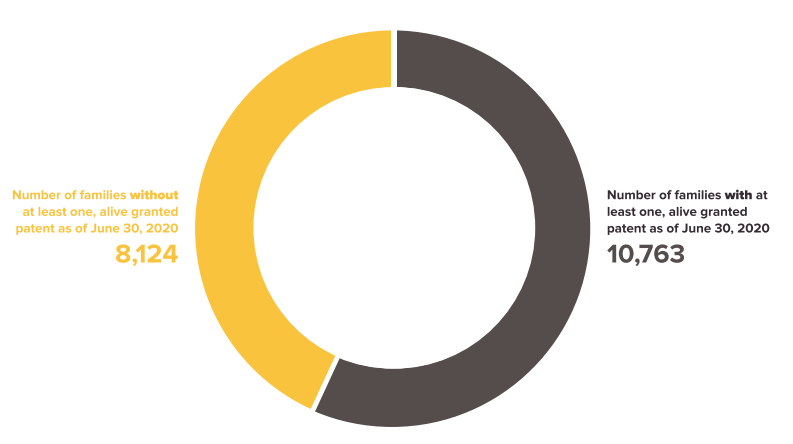
Top companies leading in declared 5G Patents

While we don’t yet have a complete picture of what products and markets will emerge, we do know who the main players are in developing this technology. To determine this, we took the 18,887 patents declared to ETSI and limited that to families that included at least one alive and granted patent as of November 26, 2019.
The largest six companies still have the majority of patent families: 65% of the declared standard essential patent families. The remaining 35% are held by approximately 70 entities.
Huawei is leading with the most declared 5G patents i.e. 3007 patent families followed by Samsung and LG with 2317 and 2147 patent families respectively. Nokia is following LG and secured the 4th position with 2047 patent families, while Ericsson and Qualcomm have 5th and 6th place.
Earlier, Ericsson had the 4th spot while Nokia was at last. Considering the recent update, Nokia seems to have declared more core 5G SEPs than Ericsson and Qualcomm.

While examining the data we found that many patents were declared not only to 5G standards but also to previous standards as well. It is perhaps not surprising to note that companies with more published applications also have a greater number of 5G-only declarations.
First 5 Years of SEP Declarations – 4G compared to 5G
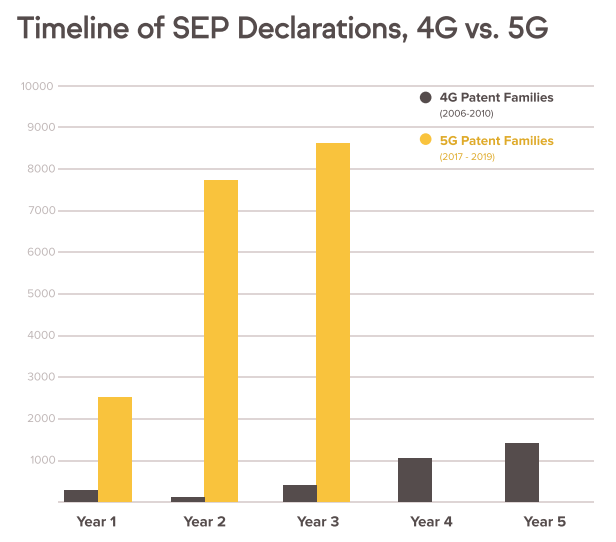
New Findings on Essentiality
Ratio of Total Core SEPs vs. Non-Core SEPs
- 18,887 Patent Families declared to ETSI as of November 26, 2019
- 10,763 of these 18,887 families with a granted, alive patent as of June 30, 2020
- 2,893 of these 10,763 families determined as core essential SEPs
Ownership breakdown of reviewed core SEPs
Distribution of core SEPs with live granted patent families
New Findings on Essentiality (Core)
Essentiality ratio of top companies’ core SEPs
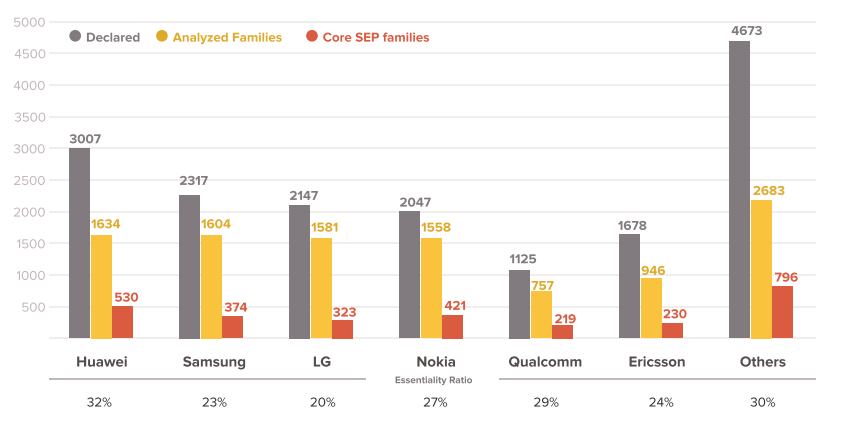 Who is this report for?
Who is this report for?
Anyone who owns or has played a hand in creating the technology covered by these standards.
Implementers who seek to commercialize this technology and need to license on SEPs.
Policymakers who seek to protect today’s innovations while encouraging tomorrow’s.
Legal professionals, judges, and courts, who need evidence of essentiality and a clear methodology to help them resolve licensing disputes.
Increasing Data Transparency
Specifically, the SEP system is plagued by a classic tragedy of the commons which can be solved by clear and ready access to information. Ideally, innovators would get well-deserved royalties for their contributions without diverting significant time, effort, and resources away from R&D towards essentiality research and disputes.
To the extent possible, we hope to encourage more objective measures that can facilitate better subjective decision-making for all parties – policymakers, innovators, manufacturers, judges, and jurors. Determining essentiality is, ultimately, subjective and vulnerable to human error. By centralizing the technical evaluation 80% of the work can be done upfront, leaving stakeholders to focus their time and effort on the remaining 20%.
So. Amplified teamed up with GreyB to create a free and open resource for understanding the patents related to 5G. We will consider our work to be a living document and invite comments and criticism from all interested parties.
Problems and Pitfalls
Reviewing historical work done in this field we’ve identified the following pitfalls which we seek to avoid:
- Extrapolating conclusions are done from a small sample size
- Using proxies from 4G and projecting those onto 5G
- Taking declared numbers at face-value
- Implicitly framing all patents as equal by focusing on patent quantity only without accounting for quality
The complex nature of patent data analysis simply makes it impossible to address these issues completely so unfortunately, it may be impossible to avoid all of these in their entirety. However, it is our goal to create a reliable report and therefore we believe it is critical to acknowledge and account for them transparently and to the best of our ability. Our methodology is detailed in the appendix and we invite corrections, additions, criticism, and contributions.
Methodology
Data Selection Criteria
The data coverage was determined by selecting patents from the ETSI website 5G declaration list November 2019 version. This covers any patent or patent application declared to the ETSI 5G standard. There is a lag between the release date of our report and the data covered due to the time-consuming nature of the manual review process.
Data Processing and Essentiality Analysis
- All patents declared to relevant 5G specifications and projects were selected resulting in 87,771 individual patent documents (granted patents, published patent applications, and non-public patent applications)
- Approximately 2,500 of these are non-public patent documents, unavailable for inspection, and were removed
- The remaining patent documents were grouped into 18,887 patent families declared as of November 26, 2019
- 10,763 of the 18,887 patent families had at least one granted, alive patent in their family as of June 30, 2020. These were the families analyzed in this report.
- To understand the patents, the claims and related embodiments for each of the 10,763 patent families granted patents as well as the correspondence history and documentation at the relevant patent office were reviewed.
- Essentiality was determined for each patent family by checking any specifications declared to be relevant by the patent holder to the SEP and recorded as “Core SEP” or not.
- We extracted more than 700 technical specifications and technical reports related to 5G technology from the 3GPP Portal, which were available as of August 31, 2020. To access the current uploaded specifications, go to 3GPP Portal, click Specifications Tab, select the checkbox 5G, and hit search, it will provide a list of all the specifications related to 5G as per 3GPP.
- Specific sections of these specifications and reports were compared to the patent claims to understand the overlap of the sections. If partial, or no, the overlap was found, we then broadened our comparison to the full group of all other specifications and repeated the overlap comparison process.
- Specifications that were not tagged as 5G according to the 3gpp portal data have not been considered.
About the authors: Muzammil Hassan – Manager at GreyB, Aman Kumar – Team Lead at GreyB, Matt Luby – Head of Solutions at Amplified IAM Top 300

